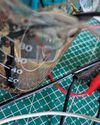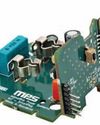PYTHON: How It Helps Run IoT Devices
Electronics For You
|February 2025
Python’s strength lies in its English-like syntax, the nimble MicroPython, and an extensive library of modules. It’s a great tool for prototyping, developing, and operating various IoT devices.

IoT, or the Internet of Things, is a technology we encounter daily. It encompasses various applications, including automatic lights controls based on presence, fan speed and AC temperature adjustments according to outdoor climate conditions, self-driving vehicles, surveillance and security systems, smart electricity meters that send monthly bills directly to your email, production lines, real-time health monitoring, and more.
IoT is defined as a network of electronic devices equipped with sensors, actuators, or accessories that possess processing capabilities through software. These devices can connect, control, and exchange data with other systems over the internet or other communication networks in real-time, enhancing decision-making processes.
Why Python
Python is widely used in IoT due to its simplicity and versatility. Here are some key reasons for its popularity.
Easy to learn and use. Python’s syntax is simple, like the English language. Also, there is a lighter version of Python, called MicroPython, which makes it a great fit for small computing resources. MicroPython is a lean and efficient Python 3 programming language implementation that includes a small part of the Python standard library, and is optimised to work on microcontrollers and in limited contexts.
Cross-platform compatibility. Python can run on multiple operating systems such as Linux, Windows, MacOS, or Raspberry Pi ensuring compatibility. In most cases, Python is preinstalled.
Existing large community. Python boasts a substantial user community actively contributing to the development of tools and support for IoT advancements.
Interoperability. Python seamlessly integrates with other languages and protocols like MQTT, HTTP, BLE, and more.
Scalability.
Esta historia es de la edición February 2025 de Electronics For You.
Suscríbete a Magzter GOLD para acceder a miles de historias premium seleccionadas y a más de 9000 revistas y periódicos.
¿Ya eres suscriptor? Iniciar sesión
MÁS HISTORIAS DE Electronics For You

Electronics For You
Tech Majors Are Racing TOWARDS NET-ZERO - What About You?
Apple, Microsoft, Amazon, Google, Infosys, Wipro—global and Indian firms are heading closer to achieving net-zero emissions, a mandate to combat climate change. Here is what you need to know to start your journey...
12 mins
December 2025

Electronics For You
Miniature IoT WATER TDS And LEVEL MONITOR Cum CONTROLLER
For setups that rely on stored water, clear awareness of tank level and water quality is essential.
3 mins
December 2025

Electronics For You
The Impact Of GENERATIVE AI On The Future Of AUTOMOTIVE AND EVs
Autonomous vehicles, connected ecosystems, and smart factories are only the beginning. Generative Al is pushing the auto industry beyond predictions into a bold era of creativity-from EV design to real-time diagnostics and showroom automation. Here is how GenAl is reshaping innovation across the automotive value chain.
8 mins
December 2025

Electronics For You
How AI Tools Are Making SOFTWARE DEVELOPMENT BETTER
AI is reshaping how we code, debug, and collaborate. From Copilot to automation, it is changing software development in ways worth exploring.
3 mins
December 2025
Electronics For You
How AI Tools Are Making SOFTWARE DEVELOPMENT BETTER
AI is reshaping how we code, debug, and collaborate. From Copilot to automation, it is changing software development in ways worth exploring.
3 mins
December 2025

Electronics For You
5 Interesting Reference Designs FOR SMART HOMES
Smart home devices are transforming the way people interact with their appliances. They make homes more convenient, secure, and energy-efficient. From smart plugs and energy monitors to smart locks and thermostats, reference designs help design engineers create connected products that are easy to use, consume less power, and are reliable. These designs allow you to control devices remotely, track energy use, extend battery life, and automate routines. They provide practical solutions for upgrading homes and small commercial spaces without major modifications.
3 mins
December 2025

Electronics For You
Fancy USB LED VASE
This USB LED vase is a simple yet elegant device that fuses art with electronics to create a decorative lighting display. Powered directly from a standard USB port, it uses readily available components such as MOSFETs, resistors, capacitors, and LEDs to produce a striking, dynamic sequence of lights.
3 mins
December 2025

Electronics For You
"WHAT OTHERS SELL IN FOUR BOXES WE BUILT IN ONE"
Years of custom field work are shaping a product line with its own cloud, its own hardware, and a market that is now beginning to recognise its value.
8 mins
December 2025

Electronics For You
BUILD LARGE LANGUAGE MODELS
Large language models are machine learning models designed for a range of language-related tasks such as text generation and translation. Here’s how open source software can help you build your own large language model.
6 mins
December 2025

Electronics For You
Rare Earth Or Rare Ingenuity? India Remains Between The Two
With China firmly controlling rare earth exports, India confronts a critical moment in its technological trajectory.
8 mins
December 2025
Listen
Translate
Change font size

